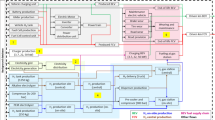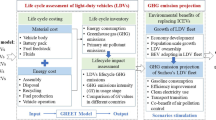Abstract
Governments all over the world are setting policies and regulations that encourage companies to incorporate Battery Electric Vehicles (BEVs) as a part of their fleet and Canada is no exception. However, BEVs struggle to deliver on a wide variety of workload needs and ambient temperature changes tend to have a greater impact on their range. This study reviewed the impact of ambient temperature on BEVs and evaluated if such depressed vehicle battery capacity can deliver required vehicle work scope for the Canadian Nuclear Laboratories (CNL) Waste Management Areas (WMA). This study focused on three-years quantitative data of Light Duty Vehicles (LDVs) operated by CNL WMA. A Total Cost of Ownership (TCO) evaluation compared BEVs to representative WMA Internal Combustion Engine (ICE) vehicles. Findings indicate that WMA LDVs mileage needs are well within the capabilities of a 150 km capacity BEV. When ambient temperature changes to 0 °C and further to −15 °C, it impacts battery capacity, reducing the aforementioned 150 km capacity BEV by 53% and 40%, respectively. Comparatively, a 250 km capacity BEV would also not translate into meeting 100% of WMA vehicle work scope without recharging when temperature impacts are considered. TCO evaluation shows cost savings in implementing BEVs over WMA ICE LDV, with or without government rebates. There is potential for BEV technology to meet WMA Small Engine Vehicles (SEVs) i.e. all-terrain vehicles (ATVs) and Utility Task Vehicles (UTVs) mileage needs without modifications, contingent on ambient temperature above −15 °C.








Similar content being viewed by others
References
Bogdan OV, Arsen S, Florin M (2019) Prediction of electric vehicle range: a comprehensive review of current issues and challenges. Energies 12:946
Deloitte (2019) New Market. New Entrants. New Challenges. Battery Electric Vehicles
Draft Technical Assessment Report: Midterm Evaluation of Light-Duty Vehicle Greenhouse Gas. Emission Standards and Corporate Average Fuel Economy Standards for Model Years 2022–2025; EPA-420-D-16–900; U.S. Environmental Protection Agency: Research Triangle Park, NC, USA, 2016.
Electrify Your Ride (2019) Plug ‘N Drive, viewed 21 November 2019. <https://www.plugndrive.ca/wp-content/uploads/2017/05/Electrify-Your-Ride_July-2019_Preview.pdf>
Figenbaum E (2017) Perspectives on Norway’s supercharged electric vehicle policy. Elsevier 25:14–34
Fulton L (2018) Ownership cost comparison of battery electric and non-plugin hybrid vehicles: a consumer perspective. Appl Sci 8:1487
Hagman J, Ritzén S, Stier JJ, Susilo Y (2016) Total cost of ownership and its potential implications for battery electric vehicle diffusion. Res Transp Bus Manag 18:11–17
Haidich AB (2010) Meta-analysis in medical research. Hippokratia 14(Suppl 1):29–37 (PMID: 21487488)
Hao X, Lin Z, Wang H, Ou S, Ouyang M (2020) Range cost-effectiveness of plug-in electric vehicle for heterogeneous consumers: An expanded total ownership cost approach. Appl Energy 275:115394
IEA (2020) Global EV Outlook 2020, IEA, Paris https://www.iea.org/reports/global-ev-outlook-2020
Lee H, Clark A (2018) Charging the future. Paper, Environment and natural resources program, Belfer Center
Lee H, Lovellette G (2011) Will Electric Cars Transform the U.S. Market? Harvard Kennedy School Faculty Research Working Paper, 2011, Series RWP11–032.
Lora P, Tribioli L (2019) Effect of ambient temperature on electric vehicles. Energy consumption and range: model definition and sensitivity analysis based on nisan leaf data, World Electric Vehicle Journal
Miao Y, Hynan P, Von Jouanne A, Yokochi A (2019) Current Li-Ion battery technologies in electric vehicles and opportunities for advancements. Energies 12:1074
NRCan (2019) Zero-Emission Vehicle Infrastructure Program, NRCan, viewed 11 November 2019. <https://www.nrcan.gc.ca/energy-efficiency/energy-efficiency-transportation/zero-emission-vehicle-infrastructure-program/21876>
Palmer K, Tate JE, Wadud Z, Nellthorp J (2018) Total cost of ownership and market share for hybrid and electric vehicles in the UK, US and Japan. Appl Energy 209:108–119
Regional Plan Association (2019) Congestion Pricing in NYC: Getting it Right. http://library.rpa.org/pdf/RPA-CongestionPricingNYC_GettingItRight.pdf
Rizalino J, Reyes MD, Parsons RV, Hoemsen R (2016) Winter happens: the effects of ambient temperature on the travel range of electric vehicles. IEEE Trans Veh Technol 65(6):4016–4022
Salisbury S (2016) Cold weather on-road testing of a 2015 Nissan Leaf. Idaho National Laboratory, INL/EXT-16–39028.
Statistic Norway (2018) STATBANK, Road traffic volumes, by type of vehicle and type of fuel 2005–2018, Road Traffic Volumes. Table 12577, Retrieved September 30, 2019. https://www.ssb.no/en/statbank/table/12577/
Transport and Environment (2019) Low-Emission Zones are a success – but they must now move to zero-emission mobility, European Federation for Transport and Environment, viewed 11 November 2019. <https://www.transportenvironment.org/sites/te/files/publications/2019_09_Briefing_LEZ-ZEZ_final.pdf>
Transport Canada (2019) Zero –emission vehicles. Retrieved December 17, 2019. https://www.tc.gc.ca/en/services/road/innovative-technologies/zero-emission-vehicles.html
Transport for London Report to the Mayor of London, December 2018, Changes to the Congestion Charge. https://www.london.gov.uk/sites/default/files/appendix_2_-_report_to_mayor_with_apx.pdf
Wagner I (2020) Market share of battery electric cars in Norway 2009–2019.Statista
Wagner I (2020) Electric vehicle market share—selected markets H1 2020. Statista
Woo J, Magee CL (2020) Forecasting the value of battery electric vehicles compared to internal combustion engine vehicles: the influence of driving range and battery technology. Int J Energ Res 44(8):6483–6501
Yuksel T, Michalek JJ (2015) Effects of regional temperature on electric vehicle efficiency, range, and emissions in the United States. Environ Sci Technol 49:3974–3980
Acknowledgements
The authors wish to thank all who assisted in conducting this work.
Author information
Authors and Affiliations
Corresponding author
Additional information
Editorial Responsibility: Samareh Mirkia.
Rights and permissions
About this article
Cite this article
Ebie, E., Ewumi, O. Electric vehicle viability: evaluated for a Canadian subarctic region company. Int. J. Environ. Sci. Technol. 19, 2573–2582 (2022). https://doi.org/10.1007/s13762-021-03312-3
Received:
Revised:
Accepted:
Published:
Issue Date:
DOI: https://doi.org/10.1007/s13762-021-03312-3




